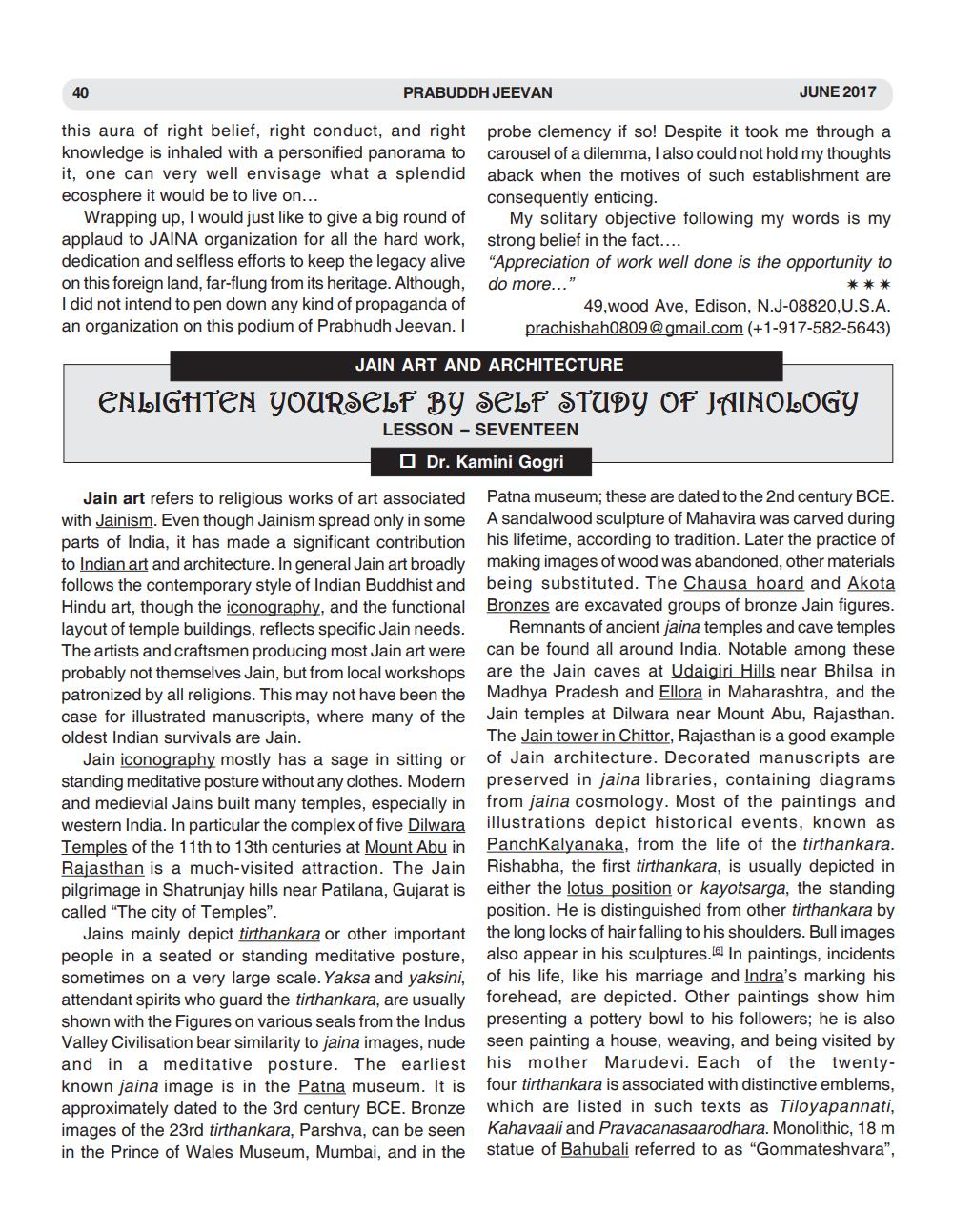________________
40
PRABUDDH JEEVAN
JUNE 2017
this aura of right belief, right conduct, and right probe clemency if so! Despite it took me through a knowledge is inhaled with a personified panorama to carousel of a dilemma, I also could not hold my thoughts it, one can very well envisage what a splendid aback when the motives of such establishment are ecosphere it would be to live on...
consequently enticing. Wrapping up, I would just like to give a big round of My solitary objective following my words is my applaud to JAINA organization for all the hard work, strong belief in the fact.... dedication and selfless efforts to keep the legacy alive "Appreciation of work well done is the opportunity to on this foreign land, far-flung from its heritage. Although, do more..." I did not intend to pen down any kind of propaganda of
49,wood Ave, Edison, N.J-08820,U.S.A. an organization on this podium of Prabhudh Jeevan. I prachishah0809@gmail.com (+1-917-582-5643)
JAIN ART AND ARCHITECTURE ENLIGHTEN YOURSELF BY SELF STUDY OF JAINOLOGY
LESSON - SEVENTEEN
O Dr. Kamini Gogri
Jain art refers to religious works of art associated Patna museum; these are dated to the 2nd century BCE. with Jainism. Even though Jainism spread only in some A sandalwood sculpture of Mahavira was carved during parts of India, it has made a significant contribution his lifetime, according to tradition. Later the practice of to Indian art and architecture. In general Jain art broadly making images of wood was abandoned, other materials follows the contemporary style of Indian Buddhist and being substituted. The Chausa hoard and Akota Hindu art, though the iconography, and the functional Bronzes are excavated groups of bronze Jain figures. layout of temple buildings, reflects specific Jain needs. Remnants of ancient jaina temples and cave temples The artists and craftsmen producing most Jain art were can be found all around India. Notable among these probably not themselves Jain, but from local workshops are the Jain caves at Udaigiri Hills near Bhilsa in patronized by all religions. This may not have been the Madhya Pradesh and Ellora in Maharashtra, and the case for illustrated manuscripts, where many of the Jain temples at Dilwara near Mount Abu, Rajasthan. oldest Indian survivals are Jain.
The Jain tower in Chittor, Rajasthan is a good example Jain iconography mostly has a sage in sitting or of Jain architecture. Decorated manuscripts are standing meditative posture without any clothes. Modern preserved in jaina libraries, containing diagrams and medievial Jains built many temples, especially in from jaina cosmology. Most of the paintings and western India. In particular the complex of five Dilwara illustrations depict historical events, known as Temples of the 11th to 13th centuries at Mount Abu in Panchkalyanaka, from the life of the tirthankara. Rajasthan is a much-visited attraction. The Jain Rishabha, the first tirthankara, is usually depicted in pilgrimage in Shatrunjay hills near Patilana, Gujarat is either the lotus position or kayotsarga, the standing called "The city of Temples".
position. He is distinguished from other tirthankara by Jains mainly depict tirthankara or other important the long locks of hair falling to his shoulders. Bull images people in a seated or standing meditative posture, also appear in his sculptures. (6) In paintings, incidents sometimes on a very large scale.Yaksa and yaksini, of his life, like his marriage and Indra's marking his attendant spirits who guard the tirthankara, are usually forehead, are depicted. Other paintings show him shown with the Figures on various seals from the Indus presenting a pottery bowl to his followers: he is also Valley Civilisation bear similarity to jaina images, nude seen painting a house, weaving, and being visited by and in a meditative posture. The earliest his mother Marudevi. Each of the twentyknown jaina image is in the Patna museum. It is four tirthankara is associated with distinctive emblems, approximately dated to the 3rd century BCE. Bronze which are listed in such texts as Tiloyapannati, images of the 23rd tirthankara, Parshva, can be seen Kahavaali and Pravacanasaarodhara. Monolithic, 18 m in the Prince of Wales Museum, Mumbai, and in the statue of Bahubali referred to as "Gommateshvara",




